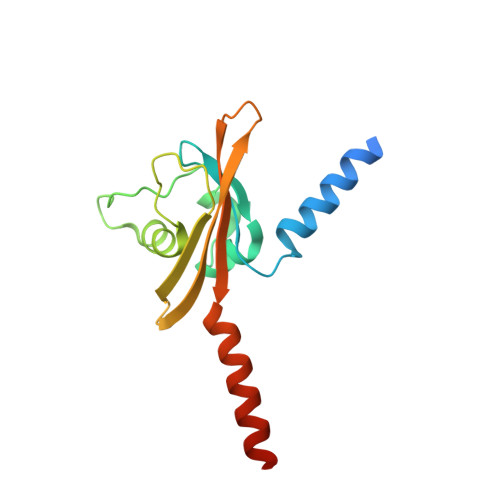Structural insight into the role of the PAS domainfor signal transduction in sensor-kinase BvgS.
Dupre, E., Clantin, B., Yuan, Y., Lecher, S., Lesne, E., Antoine, R., Villeret, V., Jacob-Dubuisson, F.(2021) J Bacteriol 203
- PubMed: 33619154
- DOI: https://doi.org/10.1128/JB.00614-20
- Primary Citation of Related Structures:
6ZJ8 - PubMed Abstract:
The two-component system BvgAS controls the virulence regulon in Bordetella pertussis BvgS is the prototype of a family of sensor histidine-kinases harboring periplasmic Venus flytrap (VFT) domains. The VFT domains are connected to the cytoplasmic kinase moiety by helical linkers separated by a Per-ARNT-Sim (PAS) domain. Antagonism between the two linkers, as one forms a coiled coil when the other is dynamic and vice versa, regulates BvgS activity. Here we solved the structure of the intervening PAS domain by X-ray crystallography. Two forms were obtained that notably differ by the connections between the PAS core domain and the flanking helical linkers. Structure-guided mutagenesis indicated that those connections participate in the regulation of BvgS activity. The PAS domain thus appears to function as a switch-facilitator module whose conformation determines the output of the system. As many BvgS homologs have similar architectures, the mechanisms unveiled here are likely to generally apply to the regulation of sensor-histidine kinases of that family. IMPORTANCE The whooping cough agent Bordetella pertussis colonizes the human respiratory tract using virulence factors co-regulated by the sensory transduction system BvgAS. BvgS is a model for a family of sensor-kinase proteins, some of which are found in important bacterial pathogens. BvgS functions as a kinase or a phosphatase depending on external signals, which determines if B. pertussis is virulent or avirulent. Deciphering its mode of action might thus lead to new ways of fighting infections. Here we used X-ray crystallography to solve the three-dimensional structure of the domain that precedes the enzymatic moiety and identified features that regulate BvgS activity. As many sensor-kinases of the BvgS family harbor homologous domains, the mechanism unveiled here might be of general relevance.
Organizational Affiliation:
Univ. Lille, CNRS, Inserm, CHU Lille, Institut Pasteur de Lille, U1019-UMR 9017 - CIIL- Center for Infection and Immunity of Lille, F-59000 Lille, France.














